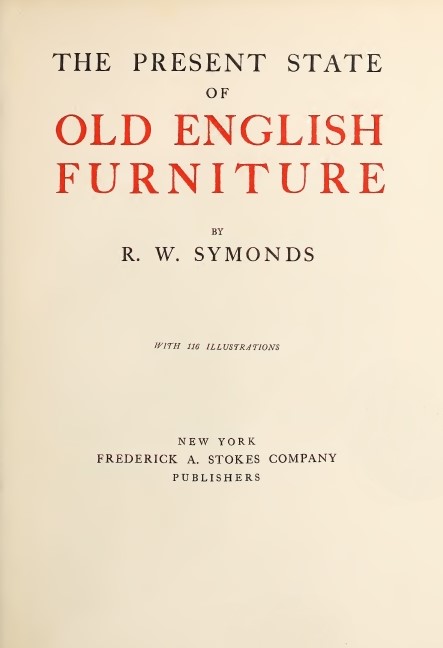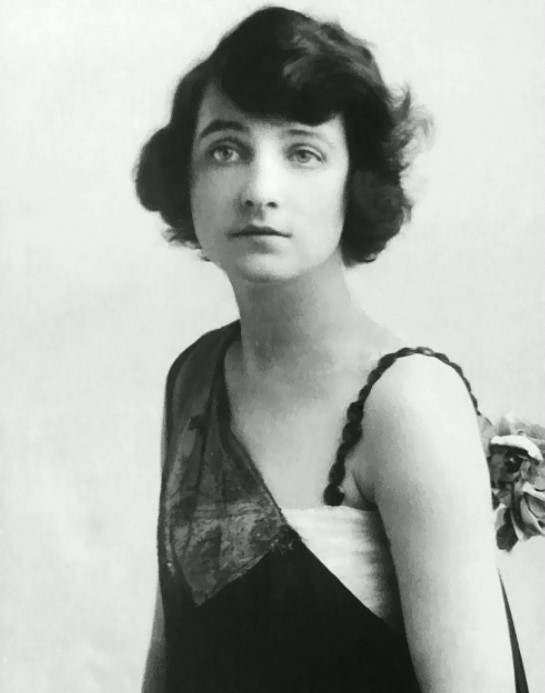R. W. Symonds on:
[Wikipedia]
[Google]
[Amazon]
 Robert Wemyss Symonds
Robert Wemyss Symonds
The Winterthur Library. Retrieved 31 May 2017. His complicated love life, before he married respectably, included affairs with two women, the first of which produced children he never acknowledged, and the second with a woman who he discovered was already married and who was subsequently jailed for perjury in her divorce case.
 Symonds also had an affair with Thelma Dorothy Bamberger who, according to his account, he met on the
Symonds also had an affair with Thelma Dorothy Bamberger who, according to his account, he met on the
by Colin Streeter and Margaret Barker, ''Furniture History'', Vol. 11 (1975), pp. 88–107.
 Symonds died at his home of The Ancient House,Advertising: Strutt & Parker, Lofts & Warner, ''The Times'', 16 April 1959, p. 24. Peasenhall, Suffolk on 5 September 1958. He was survived by his wife Monica. His research papers and approximately 9,000 photographs were acquired by the Winterthur Library in 1959.
Symonds died at his home of The Ancient House,Advertising: Strutt & Parker, Lofts & Warner, ''The Times'', 16 April 1959, p. 24. Peasenhall, Suffolk on 5 September 1958. He was survived by his wife Monica. His research papers and approximately 9,000 photographs were acquired by the Winterthur Library in 1959.
 Robert Wemyss Symonds
Robert Wemyss Symonds FRIBA
The Royal Institute of British Architects (RIBA) is a professional body for architects primarily in the United Kingdom, but also internationally, founded for the advancement of architecture under its royal charter granted in 1837, three suppl ...
(31 December 1889 – 5 September 1958) was a British architect, and "the pre-eminent 20th century scholar and authority on English furniture".Symonds, R. W. (Robert Wemyss), 1889–1958 research papers.The Winterthur Library. Retrieved 31 May 2017. His complicated love life, before he married respectably, included affairs with two women, the first of which produced children he never acknowledged, and the second with a woman who he discovered was already married and who was subsequently jailed for perjury in her divorce case.
Early life
Robert Symonds was born on 31 December 1889, the son of the artists William Robert Symonds and Margaret Hogg Swan Symonds. He was educated at St Paul's School, London."Mr. R. W. Symonds: Expert on English Furniture", ''The Times
''The Times'' is a British daily national newspaper based in London. It began in 1785 under the title ''The Daily Universal Register'', adopting its current name on 1 January 1788. ''The Times'' and its sister paper '' The Sunday Times'' ...
'', 8 September 1958, p. 10.
Family
Symonds married Daphne Loveland in 1921. They had two daughters, Anne and Virginia, before her death in 1948. Symonds married secondly Monica Sheila Harrington in 1948, the daughter of Sir H. M. Grayson, Bt. In his youth, Symonds had an affair with Lily Sapzells, a woman of Lithuanian Jewish origin, that produced two children, John (1914–2006), an author and the literary executor ofAleister Crowley
Aleister Crowley (; born Edward Alexander Crowley; 12 October 1875 – 1 December 1947) was an English occultist, ceremonial magician, poet, painter, novelist, and mountaineer. He founded the religion of Thelema, identifying himself as the prop ...
, and a daughter. Symonds did not acknowledge either child and they were brought up by their mother in Margate where she ran a boarding house.
Mrs Bamberger
 Symonds also had an affair with Thelma Dorothy Bamberger who, according to his account, he met on the
Symonds also had an affair with Thelma Dorothy Bamberger who, according to his account, he met on the London Underground
The London Underground (also known simply as the Underground or by its nickname the Tube) is a rapid transit system serving Greater London and some parts of the adjacent counties of Buckinghamshire, Essex and Hertfordshire in England.
The U ...
in 1914. He did not serve in the military during the First World War due to ill health, instead working as a designer and decorator. Symonds and Bamberger became engaged and lived together for four years despite Symonds discovering not long after they met that she was married. Symonds requested that Bamberger obtain a divorce from her husband who was serving in the military, resulting in a complicated divorce case heard in 1920 that soon after resulted in Bamberger's prosecution for perjury
Perjury (also known as foreswearing) is the intentional act of swearing a false oath or falsifying an affirmation to tell the truth, whether spoken or in writing, concerning matters material to an official proceeding."Perjury The act or an inst ...
in respect of her testimony.
Bamberger claimed that Symonds had threatened her with acid and tried to kill her, but Symonds said that he had never been violent towards her, but that she had cut his head open and on another occasion thrust a pair of curling tongs
A hair iron or hair tong is a tool used to change the arrangement of the hair using heat. There are three general kinds: ''curling irons'', used to make the hair curly, ''straightening irons'', commonly called ''straighteners'' or ''flat irons'' ...
in his ear; he also claimed that she had poured acid over him at a hotel where they were staying."Charges Against A Wife", ''The Times'', 18 March 1920, p. 5. Bamberger was found guilty of eight counts of perjury relating to her testimony in the divorce court and sentenced to nine months' imprisonment in a case that was regarded as unusual at the time due to the rareness of prosecutions for perjury arising from testimony in divorce proceedings.
Career
Symonds trained as an architect and for a time was in partnership withRobert Lutyens
Robert Lutyens (13 June 1901 – 1972) was an English interior designer, the son of the architect Sir Edwin Lutyens. He designed the interiors of the homes of several of the directors of Marks & Spencer
Marks and Spencer Group plc (commonly a ...
, the son of Sir Edwin Lutyens
Sir Edwin Landseer Lutyens ( ; 29 March 1869 – 1 January 1944) was an English architect known for imaginatively adapting traditional architectural styles to the requirements of his era. He designed many English country houses, war memoria ...
. He was consulting architect for the rebuilding of the Middlesex Hospital
Middlesex Hospital was a teaching hospital located in the Fitzrovia area of London, England. First opened as the Middlesex Infirmary in 1745 on Windmill Street, it was moved in 1757 to Mortimer Street where it remained until it was finally clo ...
in 1931–34 and after the Second World War for St Swithin's House (1949–53), built on the site of the former Salters' Hall. He was a fellow of the Royal Institute of British Architects
The Royal Institute of British Architects (RIBA) is a professional body for architects primarily in the United Kingdom, but also internationally, founded for the advancement of architecture under its royal charter granted in 1837, three suppl ...
.
Furniture and clocks
Symonds was described by The Winterthur Library as "the pre-eminent 20th century scholar and authority on English furniture", of which he was also an important collector. He designed modern furniture in what he described as the "Modern English Traditional School". He wrote extensively on furniture and also produced several books on antique clocks. Both of his first books, ''The present state of old English furniture'' (1921) and ''Old English walnut & lacquer furniture'' (1922), were highly detailed treatises on the methods of the fakers that plagued the antiques trade at that time. He also wrote on English clocks and a biography of the Restoration horologistThomas Tompion
Thomas Tompion, FRS (1639–1713) was an English clockmaker, watchmaker and mechanician who is still regarded to this day as the "Father of English Clockmaking". Tompion's work includes some of the most historic and important clocks and wat ...
in an attempt to restore his reputation. A bibliography of his works was produced by Colin Streeter and Margaret Barker and published in ''Furniture History
Furniture refers to movable objects intended to support various human activities such as seating (e.g., stools, chairs, and sofas), eating (tables), storing items, eating and/or working with an item, and sleeping (e.g., beds and hammocks). ...
'' in 1975."A Bibliography of Publications by Robert Wemyss Symonds"by Colin Streeter and Margaret Barker, ''Furniture History'', Vol. 11 (1975), pp. 88–107.
Death and legacy
 Symonds died at his home of The Ancient House,Advertising: Strutt & Parker, Lofts & Warner, ''The Times'', 16 April 1959, p. 24. Peasenhall, Suffolk on 5 September 1958. He was survived by his wife Monica. His research papers and approximately 9,000 photographs were acquired by the Winterthur Library in 1959.
Symonds died at his home of The Ancient House,Advertising: Strutt & Parker, Lofts & Warner, ''The Times'', 16 April 1959, p. 24. Peasenhall, Suffolk on 5 September 1958. He was survived by his wife Monica. His research papers and approximately 9,000 photographs were acquired by the Winterthur Library in 1959.
Selected publications
Works by Symonds include: * ''The present state of old English furniture''. Duckworth, London, 1921. * ''Old English walnut & lacquer furniture. The present-day condition and value and the methods of the furniture-faker in producing spurious pieces &c''. Herbert Jenkins, London, 1923 922 * ''English furniture from Charles II to George II. A full account of the design, material and quality of workmanship of walnut and mahogany furniture of this period; and of how spurious specimens are made''. The Connoisseur, 1929. * ''Masterpieces of English furniture and clocks. A study of walnut and mahogany furniture ... together with an account of Thomas Tompion and other famous clockmakers of the 17th and 18th centuries.'' B.T. Batsford, London, 1940. * ''A History of English Clocks.'' Penguin Books, London, 1947. ( King Penguin Books No. K28) * ''Veneered walnut furniture 1660–1760''.Alec Tiranti
Tiranti is an art supply retailer, bookstore, and former publisher based in Thatcham, Berkshire, England, Tiranti supplies Sculpture, sculptors' tools and equipment, and supplies materials for carving, mouldmaking, modelling, restoration and casti ...
, 1947.
* ''A book of English clocks''. Penguin Books, London, 1950.
* ''Thomas Tompion: His life and work.'' Batsford, London, 1951.
* ''Furniture making in seventeenth and eighteenth century England. An outline for collectors.'' The Connoisseur, London, 1955.
References
{{DEFAULTSORT:Symonds, Robert 1889 births 1958 deaths Collectors from London English non-fiction writers Architects from London Fellows of the Royal Institute of British Architects People educated at St Paul's School, London English furniture designers